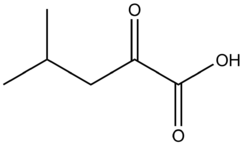알파-케토아이소카프로산

| |
| 이름 | |
|---|---|
| IUPAC 이름
4-Methyl-2-oxopentanoic acid
| |
| 체계명
4-Methyl-2-oxopentanoic acid[1] | |
| 별칭
4-Methyl-2-oxovaleric acid
| |
| 식별자 | |
3D 모델 (JSmol)
|
|
| 3DMet | |
| 1701823 | |
| ChEBI | |
| ChEMBL | |
| ChemSpider | |
| DrugBank | |
| ECHA InfoCard | 100.011.304 |
| EC 번호 |
|
| KEGG | |
| MeSH | Alpha-ketoisocaproic+acid |
PubChem CID
|
|
| UNII | |
| UN 번호 | 3265 |
CompTox Dashboard (EPA)
|
|
| |
| |
| 성질 | |
| C6H10O3 | |
| 몰 질량 | 130.143 g·mol−1 |
| 밀도 | 1.055 g cm−3 (at 20 °C) |
| 녹는점 | 8 to 10 °C (46 to 50 °F; 281 to 283 K) |
| 끓는점 | 85 °C (185 °F; 358 K) at 13 mmHg |
| log P | 0.133 |
| 산성도 (pKa) | 2.651 |
| 염기도 (pKb) | 11.346 |
| 위험 | |
EU classification (DSD) (outdated)
|
|
| R-phrases (outdated) | R34 |
| S-phrases (outdated) | S26, S36/37/39, S45 |
달리 명시된 경우를 제외하면, 표준상태(25 °C [77 °F], 100 kPa)에서 물질의 정보가 제공됨.
| |
α-케토아이소카프로산(영어: α-ketoisocaproic acid) 또는 4-메틸-2-옥소펜탄산(영어: 4-methyl-2-oxopentanoic acid)[2]은 류신의 대사 과정에서의 대사 중간생성물이다.
류신의 대사 경로[편집]
 |
각주[편집]
- ↑ (영어) 알파-케토아이소카프로산 - PubChem
- ↑ (영어) 알파-케토아이소카프로산 - PubChem
- ↑ Wilson JM, Fitschen PJ, Campbell B, Wilson GJ, Zanchi N, Taylor L, Wilborn C, Kalman DS, Stout JR, Hoffman JR, Ziegenfuss TN, Lopez HL, Kreider RB, Smith-Ryan AE, Antonio J (February 2013). “International Society of Sports Nutrition Position Stand: beta-hydroxy-beta-methylbutyrate (HMB)”. 《Journal of the International Society of Sports Nutrition》 10 (1): 6. doi:10.1186/1550-2783-10-6. PMC 3568064. PMID 23374455.
- ↑ Zanchi NE, Gerlinger-Romero F, Guimarães-Ferreira L, de Siqueira Filho MA, Felitti V, Lira FS, Seelaender M, Lancha AH (April 2011). “HMB supplementation: clinical and athletic performance-related effects and mechanisms of action”. 《Amino Acids》 40 (4): 1015–1025. doi:10.1007/s00726-010-0678-0. PMID 20607321.
HMB is a metabolite of the amino acid leucine (Van Koverin and Nissen 1992), an essential amino acid. The first step in HMB metabolism is the reversible transamination of leucine to [α-KIC] that occurs mainly extrahepatically (Block and Buse 1990). Following this enzymatic reaction, [α-KIC] may follow one of two pathways. In the first, HMB is produced from [α-KIC] by the cytosolic enzyme KIC dioxygenase (Sabourin and Bieber 1983). The cytosolic dioxygenase has been characterized extensively and differs from the mitochondrial form in that the dioxygenase enzyme is a cytosolic enzyme, whereas the dehydrogenase enzyme is found exclusively in the mitochondrion (Sabourin and Bieber 1981, 1983). Importantly, this route of HMB formation is direct and completely dependent of liver KIC dioxygenase. Following this pathway, HMB in the cytosol is first converted to cytosolic β-hydroxy-β-methylglutaryl-CoA (HMG-CoA), which can then be directed for cholesterol synthesis (Rudney 1957) (Fig. 1). In fact, numerous biochemical studies have shown that HMB is a precursor of cholesterol (Zabin and Bloch 1951; Nissen et al. 2000).
- ↑ Kohlmeier M (May 2015). 〈Leucine〉. 《Nutrient Metabolism: Structures, Functions, and Genes》 2판. Academic Press. 385–388쪽. ISBN 978-0-12-387784-0. 2016년 6월 6일에 확인함.
Energy fuel: Eventually, most Leu is broken down, providing about 6.0kcal/g. About 60% of ingested Leu is oxidized within a few hours ... Ketogenesis: A significant proportion (40% of an ingested dose) is converted into acetyl-CoA and thereby contributes to the synthesis of ketones, steroids, fatty acids, and other compounds
Figure 8.57: Metabolism of L-leucine
